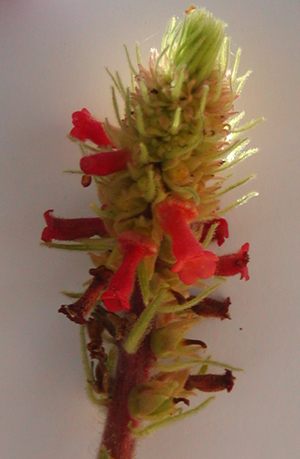| Species list |
Hybrids list |
Tubers list |
Topics list |
Site index |
What's new |
Home page |

The name "curtiflora" means "short flower", and that's no misnomer. The flowers are just about 1 cm long [less than half an inch]. See the flower size comparison. There can be a hundred of them on a stalk, however.
It might be possible to get the flower count in other plants by hybridizing with S. curtiflora. S. curtiflora x tubiflora should be interesting, although not easy to do because of the difference in pollen-tube lengths.
Dan Tomso grows S. curtiflora in the ground in North Carolina (USA), where it is very vigorous and tends to overgrow nearby plants. I grow it in large tubs, where it demands a lot of water. My attempts to grow it in the ground have not been successful. It survives the winter just fine, but evidently doesn't like my dirt.
There is a picture of Sinningia curtiflora tubers.
When grown from seed, S. curtiflora positions its tubers well down into the soil. This indicates that the tubers should be planted beneath the soil line, which is typical of most sinningias which grow in full sun. When we saw it in 1999, dozens of plants were growing together in a thick stand, with the stems, more than a meter [3 ft] high, supporting one another. This was in Brazilian autumn, so the plants were loaded with seed, from a few of which my plants are descended.
The page which discusses the incentives for a plant to make a tuber has a picture of S. curtiflora seedlings recovering from complete defoliation.
Jim Steuerlein may be the first to have made crosses with this species. The objective would be to get curtiflora's large flower count on a smaller plant with bigger flowers.
He first crossed it with 'Li'l Georgie' (S. muscicola x concinna) and got flowers which were (in his writing) "VERY tiny". He also crossed it with ('Apricot Bouquet' seedling) x sellovii. This plant has not bloomed yet [February 2011].
| Plant Description |
|
| Growth | Indeterminate |
| Habit | Stems upright from tubers which spread on runners underground |
| Leaves | Green |
| Dormancy | Stems fully deciduous, multiple tubers. Dormancy is obligate. |
Flowering |
|
| Inflorescence | extended axis |
| Season | Blooms in late summer |
| Flower | Red, tubular, very short, numerous. See a comparison with other sinningia flowers. |
Horticultural aspects |
|
| From seed | 29 months to bloom, under my conditions |
| Hardiness | Has survived 30F (-1C) in my yard. |
| Recommended? | No. The plant is large and untidy. The flowers are very small, and though numerous, few are open at any one time. Not all sinningias can be winners. |
Botany |
|
| Taxonomic group | The core group of the Corytholoma clade. |
Malme, 1937, as Corytholoma curtiflorum. Chautems transferred it to Sinningia in 1990.
Etymology: From Latin curtus ("short") + -flora ("flower"). The usual Latin adjective for "short" is brevis; curtus has secondary meanings of "gelded" and "circumcised", being derived from the root meaning of "cut".